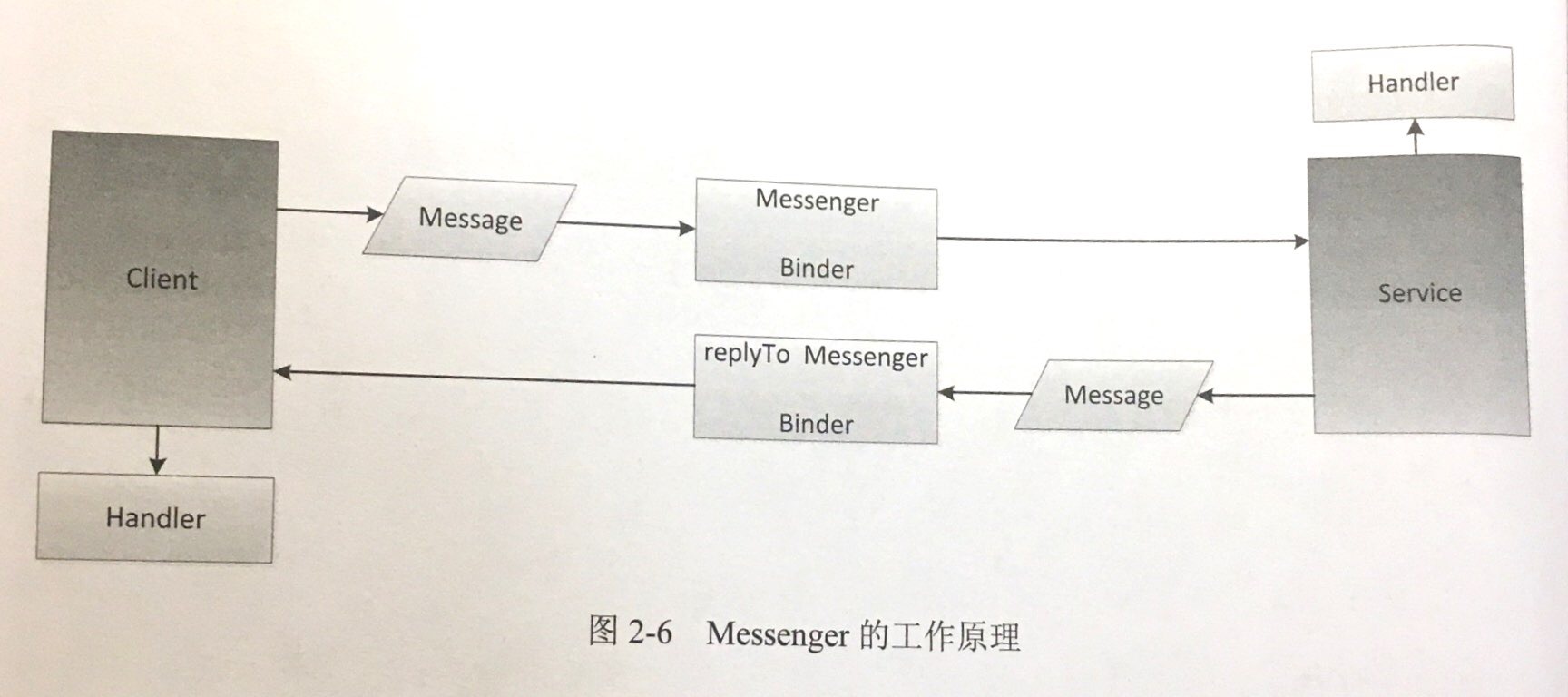Android中的IPC机制
Android IPC简介
IPC是Inter-Process Communication的缩写,含义就是进程间通信或者跨进程通信,是指两个进程之间进行数据交换的过程。那么什么是进程,什么是线程,进程和线程是两个截然不同的概念。在操作系统中,线程是CPU调度的最小单元,同时线程是一种有限的系统资源。而进程指的一个执行单元,在PC和移动设备上指的是一个程序或者一个应用。一个进程可以包含多个线程,因此进程和线程是包含被包含的关系,最简单情况下,一个进程可以只有一个线程,即主线程,在Android里面也叫UI线程,在UI线程里才能操作界面元素。
那么在Android中,有特色的进程间通信方式就是Binder了,通过Binder可以轻松实现进程间通信。除了Binder,Android还支持Socket,通过Socket也可以实现任意两个终端之间的通信,当然一个设备上的两个进程之间通过Socket通信自然也是可以的。
说到IPC的使用场景就必须提到多进程,只有面对多进程这种场景下,才需要考虑进程间通信。所有运行在不同进程中的四大组件,只要它们之间需要通过内存来共享数据,都会共享失败,这也是多进程所带来的主要影响。正常情况下,四大组件中间不可能不通过一些中间层来共享数据,那么通过简单地指定进程名来开启多进程都会无法正确运行。一般来说,使用多进程会造成如下几方面的问题:
- 静态成员和单例模式完全失效
- 线程同步机制完全失效
- SharedPreferences的可靠性下降
- Application会多次创建
为了解决这个问题,系统提供了很多跨进程通信方法,虽然说不能直接地共享内存,但是通过跨进程通信我们还是可以实现数据交互。实现跨进程通信的方式有很多,比如通过Intent来传递数据,共享文件SharedPreference,基于Binder的Messenger和AIDL以及Socket等。
IPC基础概念介绍
Serializable接口
Serializable是Java提供的一个序列化接口,它是一个空接口,为对象标准的序列化和反序列化操作。使用Serializable来实现序列化相当简单,一句话即可。
public class User implements Serializable {
private static final long seriaVersionUID = 519067123721295773L
}
Parcelable接口
Parcel内部包装了可序列化的数据,可以在Binder中自由传输,在序列化过程中需要实现的功能有序列化、反序列化和内容描述序列化功能有writeToParcel方法来完成,最终是通过Parcel中的一系列write方法来完成的。用法如下:
public class MyParcelable implements Parcelable {
// You can include parcel data types
private int mData;
private String mName;
// We can also include child Parcelable objects. Assume MySubParcel is such a Parcelable:
private MySubParcelable mInfo;
// This is where you write the values you want to save to the `Parcel`.
// The `Parcel` class has methods defined to help you save all of your values.
// Note that there are only methods defined for simple values, lists, and other Parcelable objects.
// You may need to make several classes Parcelable to send the data you want.
@Override
public void writeToParcel(Parcel out, int flags) {
out.writeInt(mData);
out.writeString(mName);
out.writeParcelable(mInfo, flags);
}
// Using the `in` variable, we can retrieve the values that
// we originally wrote into the `Parcel`. This constructor is usually
// private so that only the `CREATOR` field can access.
private MyParcelable(Parcel in) {
mData = in.readInt();
mName = in.readString();
mInfo = in.readParcelable(MySubParcelable.class.getClassLoader());
}
public MyParcelable() {
// Normal actions performed by class, since this is still a normal object!
}
// In the vast majority of cases you can simply return 0 for this.
// There are cases where you need to use the constant `CONTENTS_FILE_DESCRIPTOR`
// But this is out of scope of this tutorial
@Override
public int describeContents() {
return 0;
}
// After implementing the `Parcelable` interface, we need to create the
// `Parcelable.Creator<MyParcelable> CREATOR` constant for our class;
// Notice how it has our class specified as its type.
public static final Parcelable.Creator<MyParcelable> CREATOR
= new Parcelable.Creator<MyParcelable>() {
// This simply calls our new constructor (typically private) and
// passes along the unmarshalled `Parcel`, and then returns the new object!
@Override
public MyParcelable createFromParcel(Parcel in) {
return new MyParcelable(in);
}
// We just need to copy this and change the type to match our class.
@Override
public MyParcelable[] newArray(int size) {
return new MyParcelable[size];
}
};
}
Serializable和Parcelable区别
Serializable是Java中的序列化接口,其使用起来简单但是开销很大,在序列化和反序列化过程中需要大量的I/O操作。而Parcelable是Android中的序列化方式,因此更适合用在Android平台上,它的缺点就是使用起来稍微麻烦点,但是它的效率很高。
Binder
直观来说,Binder是Android中的一个类,它实现了IBinder接口。从IPC角度来说,Binder是Android中的一种跨进程通信方式,Binder还可以理解为一种虚拟的物理设备,它的设备驱动是/dev/binder,该通信方式在Linux中没有。从Android Framework角度来说,Binder是ServiceManager连接各种Manager(ActivityManager、WindowManager等等)和相应ManagerService的桥梁。从Android应用层来说,Binder是客户端和服务端进行通信的媒介,当bindService的时候,服务端会返回一个包含了服务端业务调用的Binder对象,通过Binder对象,客户端就可以获取服务端提供的服务或者数据,这里的服务包括普通服务和基于AIDL的服务。

Android中的IPC方式
使用Bundler
我们知道,四大组件中三大组件(activity、service、receiver)都是支持在Intent中传递Bundle数据的,由于Bundle实现了Parcelable接口,所以它可以方便地在不同的进程间传输。
使用文件共享
共享文件也是一种不错的进程间通信方式,两个进程间通过读/写同一个文件来交换数据,比如A进程把数据写入文件,B进程通过读取这个文件来获取数据。
使用Messenger
Messenger可以翻译为信使,顾名思义,通过它可以在不同进程中传递Message对象,在Message中放入我们需要传递的数据,就可以轻松地实现数据的进程间传递。Messenger是一种轻量级的IPC方案,它的底层实现是AIDL,实现Messenger有以下两个步骤,分为服务端进程和客户端进程。

使用AIDL
远程服务跨进程通信的一种方式。
使用ContentProvider
ContentProvider是Android中提供的专门用于不同应用间进行数据共享的方式,它的底层实现同样也是Binder。
使用Socket
Socket也称为“套接字”,是网络通信中的概念,它分为流式套接字和用户数据套接字两种,分别应于网络的传输控制层中的TCP和UDP协议。
选用合适的IPC方式

阅读扩展
源于对掌握的Android开发基础点进行整理,罗列下已经总结的文章,从中可以看到技术积累的过程。
1,Android系统简介
2,ProGuard代码混淆
3,讲讲Handler+Looper+MessageQueue关系
4,Android图片加载库理解
5,谈谈Android运行时权限理解
6,EventBus初理解
7,Android 常见工具类
8,对于Fragment的一些理解
9,Android 四大组件之 " Activity "
10,Android 四大组件之" Service "
11,Android 四大组件之“ BroadcastReceiver "
12,Android 四大组件之" ContentProvider "
13,讲讲 Android 事件拦截机制
14,Android 动画的理解
15,Android 生命周期和启动模式
16,Android IPC 机制
17,View 的事件体系
18,View 的工作原理
19,理解 Window 和 WindowManager
20,Activity 启动过程分析
21,Service 启动过程分析
22,Android 性能优化
23,Android 消息机制
24,Android Bitmap相关
25,Android 线程和线程池
26,Android 中的 Drawable 和动画
27,RecylerView 中的装饰者模式
28,Android 触摸事件机制
29,Android 事件机制应用
30,Cordova 框架的一些理解
31,有关 Android 插件化思考
32,开发人员必备技能——单元测试



 浙公网安备 33010602011771号
浙公网安备 33010602011771号